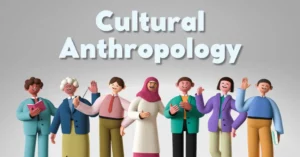AI Answer Evaluation Platform Live Now. Try Free Answer Evaluation Now
Features of Linguistic Communication
Linguistic anthropology examines how language reflects and shapes social life. Language, the backbone of human communication, is a complex system with a multitude of fascinating characteristics. The three fundamental features of linguistic communication – productivity, displacement, and arbitrariness, play a unique and pivotal role in shaping the way we use and perceive language, contributing to its dynamism and adaptability.

Productivity in Linguistic Communication
Productivity refers to the ability to produce and understand an infinite number of sentences using a finite set of grammatical rules and words [1].
Open-Ended Nature of Productivity
- It enables humans to generate new words and ideas, adapt language to evolving contexts, and form infinite sentence combinations.
- This boundless creativity is absent in the communication of other species, marking it as a unique feature of human language [2].
Productivity and Cultural Exchange
- Cultures often borrow and integrate words from other languages, enriching their vocabulary and demonstrating productivity.
- For example, English has incorporated words like ‘pasta’ from Italian and ‘sushi’ from Japanese, reflecting cultural exchange [3].
Table 1: Examples of words borrowed from other languages
| Origin Language | English Borrowed Word |
|---|---|
| Italian | Pasta |
| Japanese | Sushi |
Displacement in Linguistic Communication
Displacement refers to the capacity to talk about things that are not present, either spatially or temporally, allowing for the discussion of past events, future plans, and abstract ideas [4].
Displacement and Abstract Thinking
- It facilitates discussions about concepts, ideas, and philosophies that transcend immediate reality.
- For instance, it lets us talk about democracy, liberty, and ethics, which are abstract and not physically present [5].
Displacement in Storytelling and Learning
- It plays a critical role in storytelling, history, and education.
- Stories allow us to understand and learn from past events, while education often involves teaching about things outside immediate surroundings.
Arbitrariness in Linguistic Communication
Arbitrariness, the final key feature, indicates that there is no inherent relationship between the physical form of a language sign and its meaning.
Arbitrariness and Language Diversity
- The randomness of sound-meaning associations leads to a multitude of unique languages worldwide.
- For example, the word for ‘dog’ differs across languages – ‘chien’ in French, ‘perro’ in Spanish, and ‘inu’ in Japanese.
Table 2: Word for ‘dog’ in different languages
| Language | Word for ‘Dog’ |
|---|---|
| French | Chien |
| Spanish | Perro |
| Japanese | Inu |
Productivity, Displacement, and Arbitrariness: Their Interplay in Linguistic Communication
These three features of linguistic communication—productivity, displacement, and arbitrariness—are not standalone characteristics. They seamlessly interact and overlap to construct the dynamic entity we understand as language.
Cross-Feature Synergy
- The productivity of language allows us to construct diverse sentences and express abstract ideas made possible by the feature of displacement.
- Similarly, the arbitrariness of symbols enhances productivity, allowing the generation of a variety of expressions using different combinations of symbols.
- This interplay between productivity, displacement, and arbitrariness creates a language system of infinite possibilities.
Table 3: Interaction of language features
| Feature Interaction | Explanation |
|---|---|
| Productivity & Displacement | Enables the generation of diverse sentences and abstract expressions |
| Productivity & Arbitrariness | The arbitrary nature of symbols enhances the creation of a variety of expressions |
Impact on Sociocultural Evolution
Language, shaped by these features, plays a crucial role in the sociocultural evolution of human societies.
- Myth-Making & Cultural Preservation: The displacement aspect of language facilitates the creation of myths, legends, and oral histories, which are central to cultural preservation.
- Social Structure & Hierarchy: The productive feature of language allows the development of complex social structures and hierarchies, which are expressed and reinforced through specific linguistic patterns and vocabularies.
- Cultural Diversity: The arbitrariness of language ensures cultural diversity, as distinct societies develop unique languages with diverse phonetic, morphological, and semantic features.
Conclusion
Linguistic anthropology emphasizes that human language, marked by productivity, displacement, and arbitrariness, is an extraordinary tool that enables complex thought, communication, and culture. These features underscore the inherent flexibility and dynamism of language, allowing it to change, adapt, and grow along with human societies.
References
[1] Fromkin, V., Rodman, R., & Hyams, N. (2013). An Introduction to Language (10th ed.). Cengage Learning.
[2] Crystal, D. (2010). The Cambridge Encyclopedia of Language (3rd ed.). Cambridge University Press.
[3] Duranti, A. (1997). Linguistic Anthropology. Cambridge University Press.
[4] Hockett, C. F. (1960). The Origin of Speech. Scientific American, 203(3), 88-96.
[5] Fitch, W. T. (2010). The Evolution of Language. Cambridge University Press.

![The Cambrian Period, roughly 541 to 485.4 million years ago, marks a significant era in the history of life on Earth[1]. During this time, a remarkable explosion of diversity occurred, with the first appearance of many multicellular organisms and early forms of many major groups of animals alive today.](https://anthroholic.com/wp-content/uploads/2023/08/Cambrian-Era-in-Geological-Time-Scale-in-Archaeology-300x157.webp)


